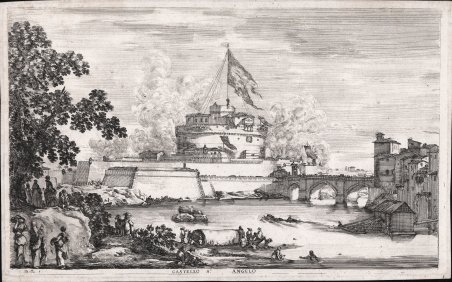Dettagli
Anno di pubblicazione
1634
Incisori
Della BELLA Stefano
Descrizione
Veduta di Castel Sant'Angelo dalla riva sinistra del Tevere; a destra il ponte e a sinistra un gruppo di donne in piedi sotto un albero che guardano verso il castello al centro; da dietro il castello, su cui sventola una grande bandiera, si leva il fumo dei colpi di artiglieria. Acquaforte, 1634 circa, incisa nel margine sotto l'immagine con il titolo e con il dettaglio della produzione: "SDBella f." Stefano della Bella fu uno degli incisori più interessanti e originali nella Firenze del XVII secolo e può considerarsi l’unico geniale continuatore dell’opera di Jacques Callot. La sua educazione artistica ebbe inizio a Firenze nella bottega degli orafi Gasparo Mola e Orazio Vanni, e la precisione del segno, tipica dell’arte orafa resterà caratteristica del suo stile. Studiò poi presso Giovanni Battista Vanni e forse anche presso il Cantagallina e Cesare Dandini, ma ben presto si dedicò all'incisione. Il suo vero maestro può considerarsi Jacques Callot, l’incisore francese che soggiornò a lungo a Firenze lasciando una forte impronta nel panorama artistico della città. Gli anni più importanti della sua carriera sono quelli che trascorre a Parigi, dal 1639 al 1650, stipendiato da Lorenzo de' Medici: lavorò insieme ad Israel Silvestre, con gli editori Langlois, Ciartres e Pierre Mariette, per stampatori francesi e per commissioni di gran prestigio, come quelle del 1641 per il cardinale Richelieu che gli affidò le illustrazioni delle sue imprese guerresche. Intorno al 1647, durante un viaggio in Olanda, dove eseguì le acqueforti con le vedute del porto di Amsterdam, incontrò Rembrandt e da quella data notiamo una eco profonda dell’arte dell’olandese nella grafica del Della Bella. Bibliografia De Vesme - Massar Stefano della Bella (1971) n. 818. View of Castel Sant'Angelo from the left bank of the Tiber; with the bridge to right and a group of women standing under a tree to left looking back towards the castle at centre; smoke from artillery fire rises from behind the castle which is flying a large flag. Etching, 1634 circa, lettered in margin below image with title and with production detail: "SDBella f." Stefano della Bella was one of the most interesting and original engravers in 17th-century Florence and can be considered the only brilliant continuator of Jacques Callot's work. His artistic education began in Florence in the workshop of the goldsmiths Gasparo Mola and Orazio Vanni, and the precision of sign, typical of the goldsmith's art, will remain characteristic of his style. He then studied under Giovanni Battista Vanni and perhaps also under Cantagallina and Cesare Dandini, but soon turned to engraving. His real master can be considered Jacques Callot, the French engraver who stayed in Florence for a long time and left a strong imprint on the city's artistic scene. The most important years of his career were the ones he spent in Paris, from 1639 to 1650, salaried by Lorenzo de' Medici: he worked together with Israel Silvestre, with the publishers Langlois, Ciartres and Pierre Mariette, for French printers and for commissions of great prestige, such as those of 1641 for Cardinal Richelieu, who entrusted him with illustrations of his warlike exploits. Around 1647, during a trip to Holland, where he executed etchings with views of the port of Amsterdam, he met Rembrandt, and from that date we note a profound echo of the Dutchman's art in Della Bella's graphic work. Bibliografia De Vesme - Massar Stefano della Bella (1971) n. 818. Cfr.

Scopri come utilizzare
Scopri come utilizzare

